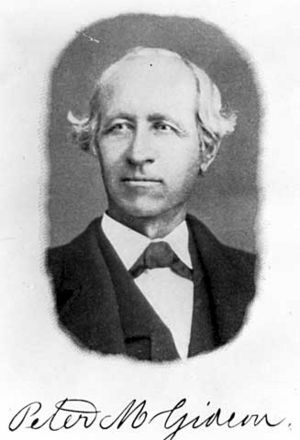Peter Gideon Farmhouse facts for kids
Quick facts for kids |
|
|
Peter Gideon Farmhouse
|
|
 |
|
| Location | Shorewood, Minnesota |
|---|---|
| Architectural style | Colonial Revival |
| NRHP reference No. | 74001019 |
| Added to NRHP | September 17, 1974 |
Peter Gideon (1820–1899) was a clever farmer who lived near Excelsior, Minnesota. He is famous for creating new types of apples that could survive the very cold winters in Minnesota. His old farmhouse, now in Shorewood, Minnesota, is a special historical place. It is listed on the National Register of Historic Places.
Contents
Peter Gideon: Apple Pioneer
Peter Gideon moved to Minnesota in 1853. He settled near Lake Minnetonka. He loved to experiment with plants. He tried growing many fruit trees. These included pear, plum, cherry, peach, and apple trees.
A Tough Start in Minnesota
After ten years, the harsh Minnesota winters had killed almost all his trees. Only one small crab apple tree survived. But Peter Gideon did not give up. He sent for more seeds and plant parts (called scions) from Bangor, Maine. He then tried a special method called grafting. This is where you join a part of one plant onto another.
The "Wealthy" Apple is Born
Peter Gideon grafted a scion onto his tough crab apple tree. This experiment worked! In 1868, he successfully grew a new kind of apple. He named it the "Wealthy" apple. He chose this name to honor his wife. The Wealthy apple was special because it could grow well in Minnesota's cold climate.

Helping Minnesota Grow Apples
In March 1878, Minnesota started a State Experimental Fruit Farm. Peter Gideon was chosen to run it. He worked there for eleven years. He planted thousands of apple trees. He also shared his best seeds with farmers all over the state. The state farm was near his land on Lake Minnetonka.
The farm was connected to the University of Minnesota. In 1889, the farm closed. Peter Gideon lost his job there. Later, he became the first leader of another farm. This was a University of Minnesota agricultural experiment station. He retired in 1889.
A Legacy of Apples
In 1907, the Minnesota Legislature started a new fruit breeding farm. It was located between Excelsior and Chaska. This farm later became the Horticultural Research Center. Today, it is part of the Minnesota Landscape Arboretum.
The center continued Peter Gideon's work. They developed another famous apple called the Haralson apple. It was introduced in 1922. Scientists later used DNA testing to find out something cool. The Wealthy apple and the Haralson apple are related! This shows how important Peter Gideon's early work was for growing apples in cold places.



